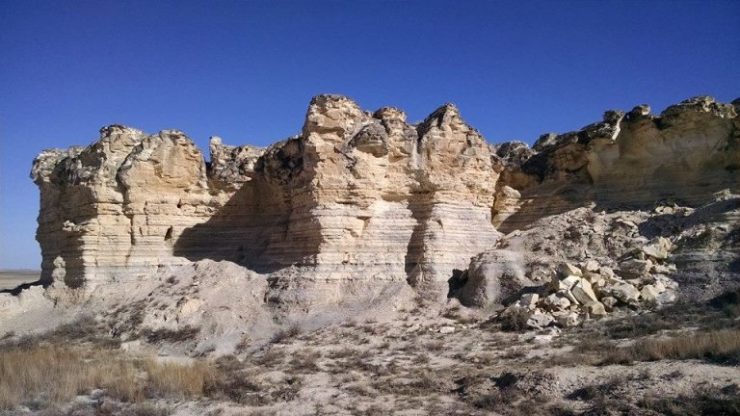
By DENA WEIGEL BELL
WaKeeney Travel Blog
WAKEENEY – With its wide open vistas and gently rolling hills, Trego County’s beautiful prairie provides a tranquil High Desert setting, but this dusty landscape hides a secret. It was once part of an amazing waterway called the Western Interior Seaway. You can find out more about that ancient seascape on a hike around Castle Rock and its adjoining badlands.

These amazing 70-foot rock formations were created during the mid-to-late Cretaceous period and very early Paleogene Era when the sea split the continent of North America into two landmasses. Water from the north flowed down the center of what is now the North American continent, emptying out into the Gulf of Mexico and carving out a trough between the Rocky and the Appalachian Mountain ranges.
Throughout this time, millions of pre-historic sea creatures left their remains in the chalk and shale seabed where they fossilized over the course of 80 million years.
Castle Rock and its adjoining badlands is a geologist’s and paleontologist’s playground.
Along the trails that crisscross the rock outcroppings, earthen pyramids, and striking white towers, or hoodoos, you’ll find the remains of sharks, mollusks, ammonites, plesiosaurs–a predatory marine reptile–giant shellfish, mosasaurs, and squid-like animals, among many others. You’ll also find fossils of the plankton-like animals that secreted the chalky platelets that give the Cretaceous Period its name and remnants of animals that roamed our prairie in more recent ancient times, like the great mammoths of the pre-historic era.
 Castle Rock gained more historical significance during America’s pioneering days when it became an identifying landmark on the Smoky Hill Trail and the Butterfield Overland Despatch. What a surprise it must have been for travelers when, after days of flat earth travel, they came upon a hidden valley of chalky cliffs!
Castle Rock gained more historical significance during America’s pioneering days when it became an identifying landmark on the Smoky Hill Trail and the Butterfield Overland Despatch. What a surprise it must have been for travelers when, after days of flat earth travel, they came upon a hidden valley of chalky cliffs!
Today’s families love the wide-open spaces and trails they find at Castle Rock and the Badlands and this is a great time to explore. The nooks and crannies can be a cozy home to modern-day wild animals, so keep an eye and ear out for snakes. The trails are all unmarked and in their natural state, with no railings or steps to aid climbers, and some of the rocks are unstable, so wear good hiking shoes.
Traveling to Castle Rock and the Badlands will take you over dirt roads and onto private property, whose owners graciously allow visitors to enter with the expectation that they respect the area and take care not to damage the site. You can make the trip over the unpaved roads in a passenger car if you go slow but it is better in a SUV or pick-up, and always be aware of the constantly changing weather conditions. And, photographers–don’t forget your cameras for amazing shots of this mythical looking landscape!
 To visit, turn south on Banner Road from Collyer (Exit #115), look for the turnoff to the Castle Rock and it’s badlands roughly 12.4 miles south of I-70 at Trego County U Road. Turn west (right) on U Rd. and go 2.8 miles into Gove County on K Road. Look for signs pointing north to Castle Rock to guide you into the pasture, then follow the path, crossing the cattle guard and driving to the bluff that overlooks Castle Rock.
To visit, turn south on Banner Road from Collyer (Exit #115), look for the turnoff to the Castle Rock and it’s badlands roughly 12.4 miles south of I-70 at Trego County U Road. Turn west (right) on U Rd. and go 2.8 miles into Gove County on K Road. Look for signs pointing north to Castle Rock to guide you into the pasture, then follow the path, crossing the cattle guard and driving to the bluff that overlooks Castle Rock.

After visiting the site, stop in at WaKeeney’s Trego County Historical Society to see just a few of the fossils that have been recovered at Castle Rock and the Badlands.
There is a great group of fossils gathered by amateur and professional paleontologists in the Leonard and Irene Purinton Collection.
Together, Castle Rock and its adjoining badlands were named as one of the Eight Wonders of Kansas by the Kansas Sampler Foundation in 2008 and is a must-do on your Kansas travel bucket list.
It is a fantastic landscape with a secret past that continues to be revealed in layers of Trego County’s prairie.
